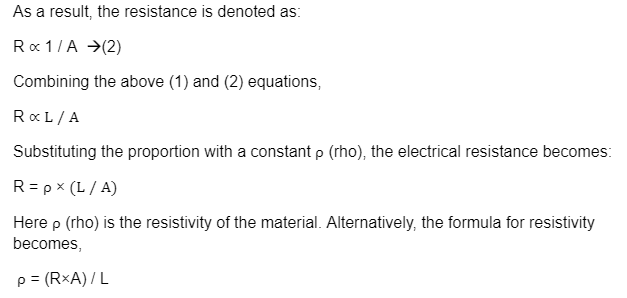When we’ve been discussing the constraints of Ohm’s Principle, you’ve probably been curious about the idea of resistance. Resistivity seems to be the condition of a substance that describes how hard it would be for electrical energy to pass through this. Insulators are substances with a significant resistivity, whereas conductors are elements having a low resistance. Resistivity has the widest range of readings of every physical attribute, ranging from 10-8 m through 1020 m. Resistivity has been required in a wide range of material uses, such as resistors within electrical wiring, dielectrics, resistive warming and superconducting.
A brief overview of resistivity
Resistivity, especially electrical resistivity, would be unquestionably exact inverse of that electrical conduction. Resistivity is indeed a basic attribute of a substance that indicates how powerfully the substance resists as well as conducts electrical currents. A minimal resistivity seems to be a clear sign of a substance that readily admits electric current. Furthermore, the Greek symbol () is commonly used to denote resistivity. Furthermore, this ohm-meter (-m) has been the SI measurement of this electrical resistivity.
Resistivity has been clearly a measurement of how powerfully a particular substance opposes the movement of electric charge on conductors as well as resistors having a specific uniform cross section. Moreover, a regular cross-section means one in which the current travels in a consistent manner. This is the resistivity definition.
Around 20° C (68° F), total resistivity of any extremely excellent electrical conductor, also including hard-drawn copper, seems to be (1.77× 10-8 ohm-metre), as well as 1.77× 10-6 ohm-centimetre. Electromagnetic insulators, on the other hand, exhibit resistivities ranging from 1012 through 1020 ohm-metres.
The amount of resistivity has been similarly affected by the warmth of the substance; resistivity statistics typically provide values under 20° C. The resistivity of solid conductors normally climbs as temperature rises, but the resistance of semiconductors, including such carbon as well as silicon, reduces as temperature rises.
Equation for Resistivity
The resistivity formula is written as follows:
Resistivity = 1÷conductivity
The formula can be expressed as: =1÷ 𝜎
where,
𝜎 = Conductivity
= Resistivity
In addition, another equation for resistivity may be used:
= RA ÷ L
Here,
= resistivity
R = resistance
A = cross-sectional area of the conductor
L = length
Derivation of the Resistivity Formula
The resistivity R is clearly proportionate to this conductor length. It shows that resistance rises as the span of the conductor grows.
As a result, the resistance is denoted as:
R L 🡪(1)
Secondly, resistance is inversely related to the size of the crossed section of any specific conductor, which implies that when the surface of one conductor increases, resistance decreases and vice versa. Greater conductor area results in an increased efficient passage of electric charge via more area, lowering resistance.

The resistivity of a material is directly proportional to the area and inversely proportional to the length of the material.
Resistivity has the following practical implications
Substance resistivity is significant because it allows the proper materials to be utilised in the appropriate places within electrical as well as electronic devices.
Materials utilised as conductors, such as electrical as well as ordinary connecting wires, must have a minimal level of resistance. This indicates that the resistivity of the wires would be reduced for a certain cross-sectional region. Knowing the qualities of a substance, such as its resistivity, seems to be essential for selecting the appropriate one.
Copper, for instance, is an excellent conductor because it has a low degree of resistivity, may not be too expensive and has other physical properties that are beneficial in various electrical as well as electronic applications.
Copper has a resistance of about (1.7 x 10-8 ohm metre) (or 17. n Ω m), though numbers may vary slightly depending on the quality of that copper.
Materials with low resistance, such as copper as well as sometimes even aluminium, render them suitable for usage as electrical lines and cables, with copper becoming a popular choice. Silver, as well as gold, possess substantially lower resistivity ratings, but because they remain much more costly, they really aren’t generally utilised. Yet, silver is often used to coat wires when low resistance is required, while gold flashing has been utilised on the mated areas of many electrical connections to provide the best connections. Gold is especially ideal for electrical connections since this does not rust or deteriorate like other elements.
Certain materials must behave as insulators, transferring such little energy as feasible. The resistance of such an insulator would be multiple orders of scale higher. One instance is air, which has a high resistivity value of about (1.5 x 1014), which is clearly far greater than the resistance of this copper.
Electrical resistance is crucial in several other electrical parts. With resistors, for instance, the resistance of different materials is critical in ensuring that resistors possess the proper resistance.
Resistivity seems to be also essential in other electrical components. The resistance of the substances used for integrated circuits would be critical. Some materials must have very poor resistance and be capable of connecting multiple sections of the Circuit internally, whereas others must isolate distinct areas. Again, resistance is required to make that happen.
Resistivity seems to be important in many sectors of electronic parts and also numerous electrical parts.
Conclusion
Electrical resistivity is indeed a critical property for materials used in electrical as well as electronic devices. Insulators are materials that have significant electrical resistance and could be employed for this reason. This is really a great conductor having a lower amount of electrical resistance and could be utilised in a variety of applications ranging from wires to electrical connectors and far more.
 Profile
Profile Settings
Settings Refer your friends
Refer your friends Sign out
Sign out






